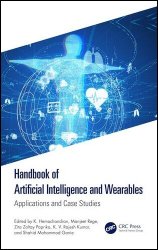Handbook of Artificial Intelligence and Wearables: Applications and Case Studies
- Добавил: literator
- Дата: 15-02-2024, 04:26
- Комментариев: 0
 Название: Handbook of Artificial Intelligence and Wearables: Applications and Case Studies
Название: Handbook of Artificial Intelligence and Wearables: Applications and Case StudiesАвтор: Hemachandran K, Manjeet Rege, Zita Zoltay Paprika, K. V. Rajesh Kumar
Издательство: CRC Press
Год: 2024
Страниц: 409
Язык: английский
Формат: pdf (true)
Размер: 23.4 MB
The ever-changing world of wearable technologies makes it difficult for experts and practitioners to keep up with the most recent developments. This handbook provides a solid understanding of the significant role that AI plays in the design and development of wearable technologies along with applications and case studies.
Handbook of Artificial Intelligence and Wearables: Applications and Case Studies presents a deep understanding of AI and its involvement in wearable technologies. The book discusses the key role that AI plays and goes on to discuss the challenges and possible solutions. It highlights the more recent advances along with real-world approaches for the design and development of the most popular AI-enabled wearable devices such as smart fitness trackers, AI-enabled glasses, sports wearables, disease diagnostic devices, and more, complete with case studies.
A subfield of Artificial Intelligence called “Machine Learning” focuses on creating algorithms that let computers learn from data and make predictions or judgments without having to be explicitly programmed. It includes teaching computers to spot patterns in massive volumes of data so they may base their predictions and judgments on that knowledge. With the help of supervision, the algorithm can learn from examples and forecast results for future, unlabeled data by being fed labeled data. Important ideas include reinforcement learning (sequential decision-making based on rewards), unsupervised learning (identifying patterns in unlabeled data), and supervised learning (using labeled examples for prediction). Preprocessing for wearable data includes data cleansing and transformation, whereas feature extraction concentrates on obtaining important data. It is crucial to comprehend these ideas in order to apply machine learning to real-world issues. Machine Learning is critical for deriving important insights from massive volumes of data gathered by wearable sensors. It allows for pattern identification, anomaly detection, tailored treatments, and real-time monitoring, and it feeds R&D activities. We can unleash the full potential of wearable devices by leveraging the power of Machine Learning, improving healthcare outcomes, enhancing well-being, and furthering our understanding of human behavior. Personalized health, well-being, real-time monitoring, intervention, enhanced research, and development are some of the essential benefits of Machine Learning in smart wearables.
Integration with Artificial Intelligence (AI) and Machine Learning (ML) in smart glasses opens up a wide range of possibilities and applications that will enhance functionality and take the capabilities of these wearable devices to the next level. AI algorithms can be used to enable object and image recognition capabilities in smart glasses. This will allow users to identify and gather information about the objects that are in sight of them, it can also detect landmarks, people, or text simply by looking at them. ML algorithms will continuously learn and will continuously improve the recognition accuracy over time. AI and ML will also be employed to provide real-time, context-aware AR overlays on the smart glasses’ display. Enhancing the visual experience of the glasses is achievable by analyzing the user's surroundings and utilizing Machine Learning models. This capability enables the glasses to add pertinent information or virtual objects to the user's field of view. Smart glasses with built-in AI can be able to utilize facial recognition technology to identify individuals in real time for better safety and security. This will be used particularly in various professional fields such as law enforcement, security, or customer service, where quick identification of people is important. By integrating natural language processing (NLP) capabilities, it will be possible to understand and interpret voice commands, enabling hands-free operation. Users can interact with the glasses by giving verbal instructions, asking questions, or even having conversations with AI assistants. With AI algorithms, they will be able to analyze user preferences, user behavior, and historical data to provide personalized recommendations directly on the smart glasses’ display. This can be useful for suggesting relevant content to the user, as well as product recommendations, or services based on the user’s interests and context.
This book will be a valuable source for researchers, academics, technologists, industrialists, practitioners, and all people who wish to explore the applications of AI and the part it plays in wearable technologies.
Скачать Handbook of Artificial Intelligence and Wearables: Applications and Case Studies
Внимание
Уважаемый посетитель, Вы зашли на сайт как незарегистрированный пользователь.
Мы рекомендуем Вам зарегистрироваться либо войти на сайт под своим именем.
Уважаемый посетитель, Вы зашли на сайт как незарегистрированный пользователь.
Мы рекомендуем Вам зарегистрироваться либо войти на сайт под своим именем.
Информация
Посетители, находящиеся в группе Гости, не могут оставлять комментарии к данной публикации.
Посетители, находящиеся в группе Гости, не могут оставлять комментарии к данной публикации.
